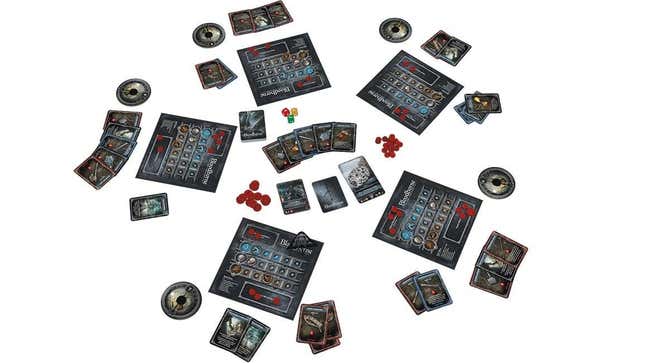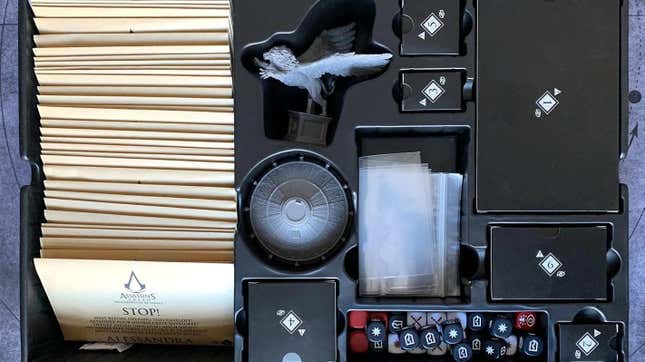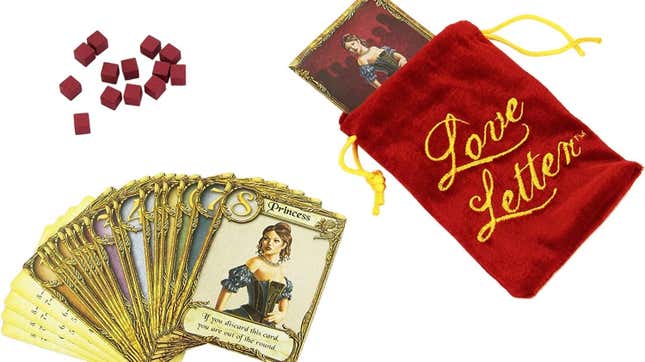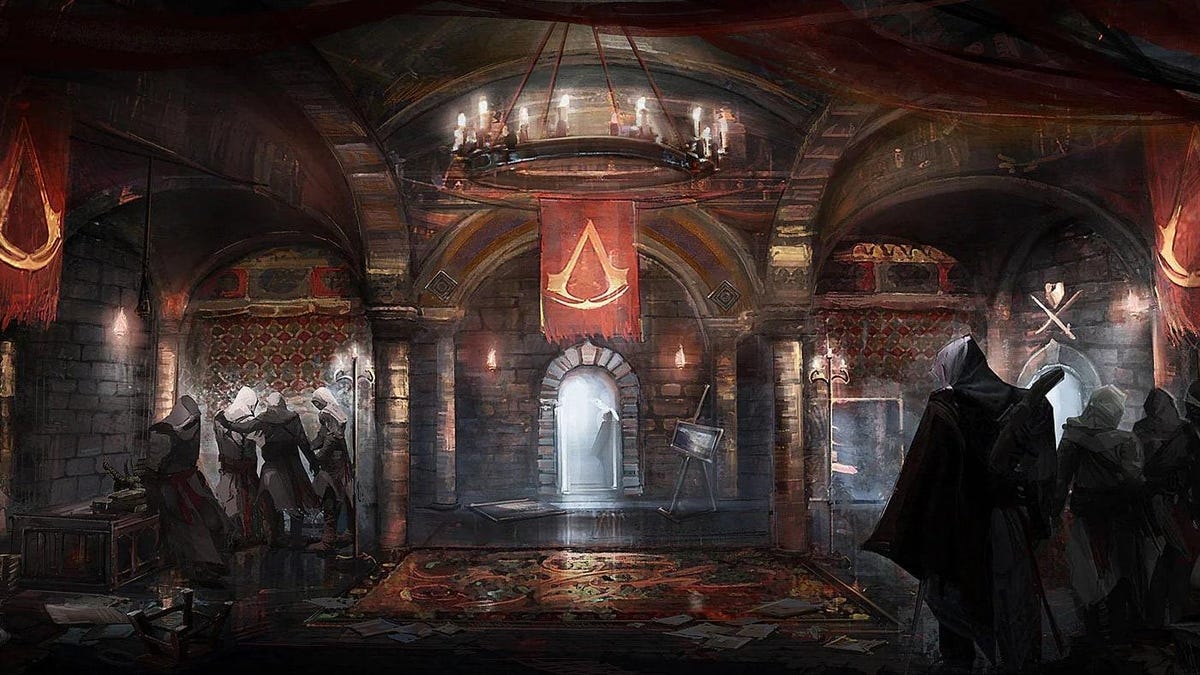Between my PC, PS5, Switch, GameCube (yeah, I still have one of those), iPhone, and my friend’s Xbox 360 (yeah, he still has one of those), it’s hard not to feel completely boxed in by screens leaking evil, sleep-disrupting blue light. Though I like playing games every day, I also have screen fatigue, and I’ve been trying to angle myself more toward eyeball-compatible board games.
I’ve historically been somewhat anti-board game; blue light screens raised me, and I’m used to their steady streams of dopamine and constant satisfaction, both of which the more action-oriented video games I like to play (Dark Souls, Guilty Gear, Doom, when it’s not making me want to throw up) offer earnestly.
Board games, at least for me, are comparatively slower burns with steeper learning curves, but with TikTok at risk and Facebook plagued by conspiracy theorists and Zuckerberg’s terrifying feet, it feels important to learn how to slow down with satisfaction.
Our house of screens is caving in, so I’m offering you (and myself) four video game-inspired board games to help make it out safely. They should provide a much more exciting experience than touching grass.
Swap your video games for these great board games

G/O Media may get a commission

Save all week long
Discover Samsung Event Week-Long Deals
Save on smartphones, TVs, appliances, and more
The spring Discover Samsung Event has sprung, and that means it’s a great time to save on Samsung Galaxy smartphones, 4K and 8K TVs, monitors, soundbars, home appliances, and more.
Based on a video game—Bloodborne: The Card Game
Like FromSoftware’s 2015 gothic horror Bloodborne, the card game version (released the year after) dwells on monsters. It was created by renowned board game designer Eric M. Lang, who you might be familiar with if you played Blood Rage, or Star Wars: The Card Game, or remember the time Lang was wrongly kicked from Twitter.
The Card Game requires you and up to four other Hunters to enter its Chalice Dungeon (those dangerous chambers crawling with bonus bosses in the PlayStation game) and pick up weapons and items on cards to defeat strange creatures.
Every image you see displayed on the cards is a graphic taken from the original game, and so are many of the card game’s conventions, including the Blood Echoes you earn as points. If you’re already a Bloodborne fan, The Card Game’s experience will feel familiar even if you don’t have much card game experience. But newcomers have something to gain, too.
Your end goal is to emerge as the Dungeon’s sole victor, and the process of getting to it involves fast, bloody decisions. The result is a gaming experience more fast-paced but equally as macabre as the video game.
“My goal with Bloodborne was to channel the intensity and frustration of the video game into a contest between players,” Lang said in 2016. “Lots of death.”
Made for: 3-to-5 players
Can be completed in: thirty minutes to an hour, the same time it takes to decide what to watch on YouTube
Inspired a video game spinoff—Elder Sign
Elder Sign is an unearthly game from Arkham Horror designers Richard Launius and Kevin Wilson. Released in 2011 but set in 1926, the cooperative dice game requires up to eight players to stave off the Ancient One’s attack on humanity by discovering Elder Signs to lock it up with.
Its premise reminds me a bit of 2010 survival horror Amnesia: The Dark Descent; both games are about avoiding a great evil and shredding your sanity in the process, though Elder Sign’s art is more vibrant and lively, for giving you more high-contrast creeps.
An iOS offshoot Elder Sign: Omens was released in the same year, and made it to PC in 2013. Ignore that fact until you get your screen time down.
Made for: 1-to-8 players
Can be completed in: An hour and a half, the same time it takes to catch yourself mindlessly scrolling Twitter

Provided an analog video game sequel—Assassin’s Creed: Brotherhood of Venice
Ubisoft’s game Assassin’s Creed Brotherhood was the best Assassin’s Creed in 2010 when Stephen Totilo reviewed it for Kotaku, and 2021 co-op miniature board game Assassin’s Creed: Brotherhood of Venice nobly follows its colossal footsteps.
Though it tells a similar story—both Brotherhood and Brotherhood of Venice take place in Renaissance-era Italy, involve stealthing around enemies, and as is necessary for the franchise, assassinating them on occasion—it isn’t exactly a “sequel,” more of a reshuffling.
Regardless of how you’d define it, it does feel like an Assassin’s Creed game, senior editor Luke Plunkett writes in his Kotaku review, “dropping almost instantly into the series’ labyrinthine lore with a story that continues through each mission.”
But note, too, that “Brotherhood of Venice has managed to let some of the franchise’s bloat and tedium creep in,” Plunkett continues. “Basically, I found this game too big.” With all the pieces packed in, the box weighs over 10 pounds, for size reference. But sometimes I do feel like it would take a brick to get me off my devices.
Made for: 1-to-4 players
Can be completed in: thirty minutes to an hour and a half, the same time you spend checking your phone screen for new notifications throughout the day

I wish it was a video game—Love Letter
Love Letter is a short-and-sweet deduction game from 2012. In it, your goal is to successfully pass your love letter to the reluctant Princess Annette by sabotaging other players. There are Marvel and Lovecraft versions of the game, too, if that’s more your speed.
No matter what themed Love Letter deck you choose, I wish video games would add a drop of romantic comedy to their action role-playing games the way I feel this game does. But it’s OK. It’s a good reminder that there are some things you can only discover offline.
Made for: 2-to-4 players
Can be completed in: twenty minutes, or how long I wish I watched the sun set
What are some of your favorite board games to play instead of video games? Leave me some recommendations in the comments.







